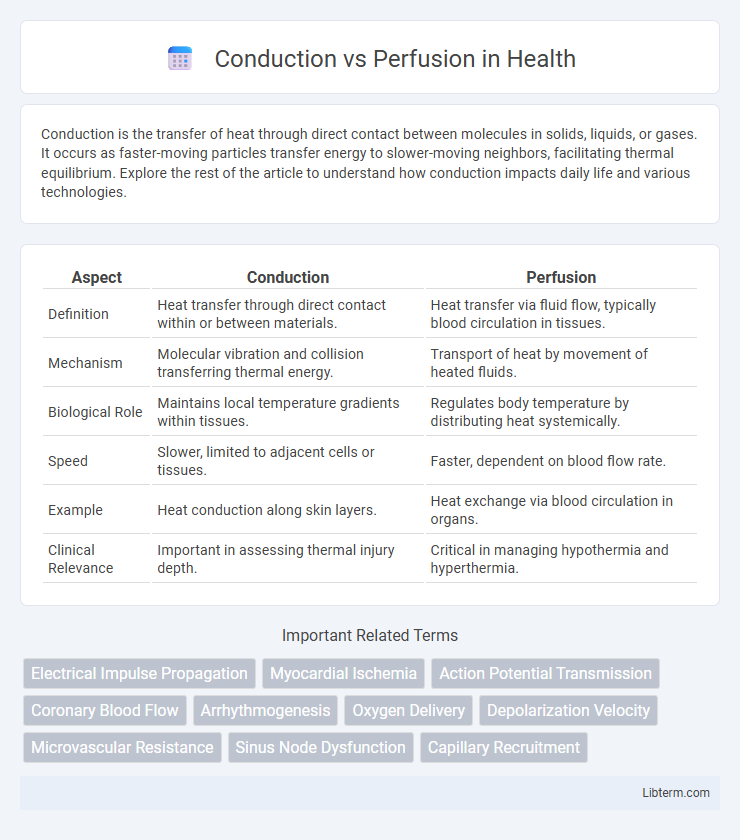Conduction is the transfer of heat through direct contact between molecules in solids, liquids, or gases. It occurs as faster-moving particles transfer energy to slower-moving neighbors, facilitating thermal equilibrium. Explore the rest of the article to understand how conduction impacts daily life and various technologies.
Table of Comparison
| Aspect | Conduction | Perfusion |
|---|---|---|
| Definition | Heat transfer through direct contact within or between materials. | Heat transfer via fluid flow, typically blood circulation in tissues. |
| Mechanism | Molecular vibration and collision transferring thermal energy. | Transport of heat by movement of heated fluids. |
| Biological Role | Maintains local temperature gradients within tissues. | Regulates body temperature by distributing heat systemically. |
| Speed | Slower, limited to adjacent cells or tissues. | Faster, dependent on blood flow rate. |
| Example | Heat conduction along skin layers. | Heat exchange via blood circulation in organs. |
| Clinical Relevance | Important in assessing thermal injury depth. | Critical in managing hypothermia and hyperthermia. |
Introduction to Conduction and Perfusion
Conduction is the direct transfer of heat through a solid medium by molecular vibration, playing a critical role in heat regulation in biological tissues and engineering systems. Perfusion refers to the process of blood flow delivering oxygen and nutrients to tissues, essential for maintaining cellular function and metabolic activity. Understanding the balance between conduction and perfusion is vital in medical treatments such as thermal therapies and in designing efficient heat exchange systems.
Definition of Conduction
Conduction is the transfer of heat through a material or between objects in direct physical contact, occurring at the molecular level as kinetic energy passes from hotter to cooler areas. This process is fundamental in biological systems where heat moves through tissue without movement of the tissue itself. In contrast, perfusion involves the movement of heat via blood flow, distributing warmth throughout organs and tissues.
Definition of Perfusion
Perfusion refers to the process of delivering blood to the capillary bed in biological tissue, ensuring oxygen and nutrient exchange essential for cellular metabolism. It is a critical parameter in medical fields such as cardiology and critical care to assess tissue viability and organ function. Unlike conduction, which involves heat transfer through a medium, perfusion specifically pertains to blood flow dynamics within the circulatory system.
Key Differences Between Conduction and Perfusion
Conduction involves the direct transfer of heat or electrical impulses through a solid medium, relying on molecular collisions, while perfusion refers to the flow of blood or fluid through biological tissues, ensuring oxygen and nutrient delivery. Conduction occurs at a microscopic level within tissues or materials, whereas perfusion operates at a macroscopic scale involving vascular systems. The primary difference lies in conduction's focus on energy transfer in solids versus perfusion's role in fluid transport and metabolic exchange in living organisms.
Physiological Importance of Conduction
Conduction in physiology refers to the transmission of electrical impulses through neurons or cardiac muscle fibers, essential for coordinating rapid communication within the nervous and cardiovascular systems. Efficient conduction ensures timely contraction of the heart, maintaining synchronized heartbeat and optimal blood circulation. This process is crucial for sustaining life by enabling immediate responses to stimuli and preserving homeostasis through controlled signal propagation.
Physiological Importance of Perfusion
Perfusion is crucial for maintaining tissue viability by ensuring the continuous delivery of oxygen and nutrients through the bloodstream, which supports cellular metabolism and waste removal. It plays a vital role in regulating body temperature and maintaining homeostasis by facilitating heat exchange and distributing hormones. Inadequate perfusion can lead to ischemia and organ dysfunction, highlighting its physiological importance in sustaining overall health.
Conduction and Perfusion in Cardiovascular Health
Conduction in cardiovascular health refers to the electrical impulses generated by the sinoatrial node that regulate heart rhythm and ensure synchronized myocardial contraction. Perfusion involves the delivery of oxygenated blood through coronary arteries to myocardial tissue, critical for sustaining cardiac function and preventing ischemia. Impaired conduction can lead to arrhythmias, while inadequate perfusion results in myocardial infarction or heart failure, highlighting their essential roles in maintaining cardiovascular stability.
Disorders Affecting Conduction
Disorders affecting conduction primarily involve abnormalities in the heart's electrical system, such as arrhythmias, atrioventricular (AV) block, and bundle branch blocks, which disrupt the normal propagation of electrical impulses. These conditions can lead to inefficient heartbeats, reduced cardiac output, and potentially life-threatening complications like syncope or sudden cardiac arrest. Accurate diagnosis through ECG and timely interventions such as pacemaker implantation are crucial to managing conduction disorders and maintaining proper myocardial perfusion.
Disorders Affecting Perfusion
Disorders affecting perfusion include conditions such as peripheral artery disease, heart failure, and shock, which impair the delivery of oxygenated blood to tissues. Impaired perfusion leads to tissue hypoxia, cellular injury, and organ dysfunction if untreated. Early diagnosis and management are critical to restore adequate blood flow and prevent complications like ischemia and necrosis.
Summary: Clinical Implications and Future Directions
Conduction and perfusion critically influence tissue oxygenation, with conduction referring to heat transfer through tissues and perfusion involving blood flow delivering oxygen and nutrients. Clinical implications highlight the importance of monitoring both processes in conditions like ischemia, where impaired perfusion and altered conduction contribute to tissue damage. Future directions focus on developing advanced diagnostic tools and targeted therapies to optimize tissue oxygenation by enhancing both conduction and perfusion efficiency.
Conduction Infographic

 libterm.com
libterm.com